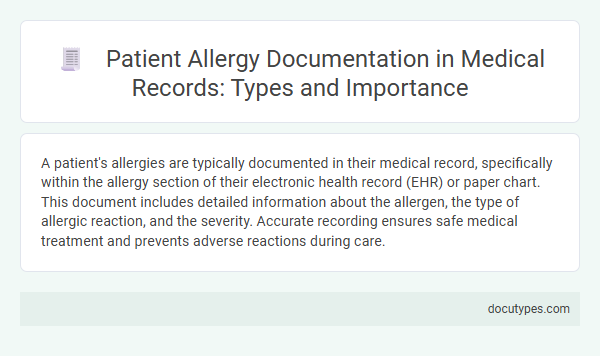A patient's allergies are typically documented in their medical record, specifically within the allergy section of their electronic health record (EHR) or paper chart. This document includes detailed information about the allergen, the type of allergic reaction, and the severity. Accurate recording ensures safe medical treatment and prevents adverse reactions during care.
Introduction to Patient Allergy Documentation
What type of document records a patient's allergies? A patient's allergies are typically documented in their medical record, which is a comprehensive file maintained by healthcare providers. This record ensures your allergies are accessible during any medical treatment or emergency, enhancing patient safety.
Types of Allergies Recorded in Medical Records
| Type of Document | Description | Common Allergies Recorded |
|---|---|---|
| Electronic Health Record (EHR) | Centralized digital record of a patient's medical history, treatments, and diagnostic information. | Drug allergies (e.g., penicillin, sulfa drugs), Food allergies (e.g., nuts, shellfish), Environmental allergies (e.g., pollen, dust mites), Latex allergy |
| Allergy Alert Form | Specific document used within healthcare settings to flag important allergy information for immediate clinical reference. | Medication allergies, Food allergies, Insect sting allergies |
| Medication Administration Record (MAR) | Document recording all medications administered to a patient, often includes allergy notes to prevent adverse reactions. | Drug allergies, Sensitivity reactions |
| Patient History Form | Intake form used during initial visits to collect comprehensive patient medical background including allergies. | Food allergies, Drug allergies, Environmental allergies, Contact allergens |
| Consent Form | Legal document where patients disclose allergy information prior to procedures or treatments to ensure safety. | Severe allergies relevant to planned procedures, Medication allergies |
Clinical Importance of Allergy Documentation
Accurate documentation of a patient's allergies is critical for safe medical care and effective treatment planning. The primary type of document used to record allergy information is the patient's electronic health record (EHR), which ensures accessibility across healthcare settings.
- Electronic Health Record (EHR) - Centralized digital record that includes detailed allergy information accessible by all healthcare providers.
- Allergy Alert Forms - Specialized documents within medical charts highlighting severe allergic reactions to prevent medication errors.
- Medication Administration Records (MAR) - Records that incorporate allergy data to avoid prescribing contraindicated drugs during treatment.
Proper allergy documentation plays a vital role in preventing adverse drug reactions and improving patient safety.
Methods for Collecting Allergy Information
Patient allergies are commonly documented in the medical history section of an Electronic Health Record (EHR). Methods for collecting allergy information include patient interviews, allergy questionnaires, and reviewing prior medical records. Accurate allergy documentation is crucial for preventing adverse drug reactions and ensuring safe treatment plans.
Standardized Allergy Terminologies and Codes
Allergy information for patients is recorded in Electronic Health Records (EHRs) using standardized allergy terminologies and codes. These codes ensure consistency and accuracy in documenting your allergies across healthcare systems.
Common standardized codes include SNOMED CT, LOINC, and RxNorm, which classify allergens and reactions precisely. Using these terminologies helps clinicians quickly identify and manage allergy risks to provide safe and effective care.
Electronic Health Records and Allergy Data
Electronic Health Records (EHR) are the primary type of document used to record a patient's allergies. These records ensure allergy data is easily accessible and up-to-date for healthcare providers.
- Allergy Section in EHR - This specific section within the EHR stores detailed information about your allergies, including substances and reactions.
- Structured Allergy Data - Allergy information is entered in a structured format, enabling quick identification of potential allergens during treatment.
- Real-Time Updates - Healthcare professionals can update allergy records in real time, improving patient safety during medical encounters.
Challenges in Accurate Allergy Documentation
Allergy documentation is typically recorded in a patient's medical record, specifically within the electronic health record (EHR) system. This document is crucial for ensuring safe medical care by alerting healthcare providers to potential allergic reactions.
Challenges in accurate allergy documentation include incomplete patient history, variations in terminology, and lack of standardization across healthcare systems. Miscommunication between patients and providers can lead to missing or incorrect allergy information. Your healthcare team must maintain precise and up-to-date allergy records to prevent adverse drug reactions and improve patient safety.
Impact of Allergy Documentation on Patient Safety
Allergy documentation is a critical component of a patient's medical record that ensures healthcare providers are aware of any allergic reactions or sensitivities. Proper recording of allergies significantly enhances patient safety by preventing adverse drug events and allergic reactions.
- Allergy List in the Electronic Health Record (EHR) - This document formally captures all known patient allergies, offering instant access to clinicians during diagnosis and treatment.
- Patient History Form - Allergy information collected during patient intake helps identify potential risks early in the care process.
- Medication Administration Record (MAR) - Highlighting allergies on the MAR prevents administration of contraindicated medications, directly protecting your health.
Legal and Regulatory Considerations
Allergy information is typically recorded in a patient's medical record, which serves as the official documentation within healthcare settings. This record ensures accurate communication of allergen sensitivities to all healthcare providers involved in the patient's care.
Legal and regulatory frameworks, such as HIPAA in the United States, require that allergy documentation is precise, accessible, and securely maintained. Compliance with these regulations helps prevent medical errors and protects patient safety while safeguarding personal health information.
What Type of Document Records a Patient’s Allergies? Infographic

